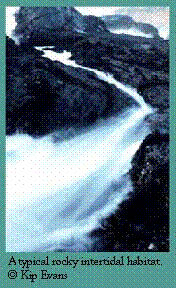Rocky Intertidal Habitats
I. Introduction
Monterey Bay National Marine Sanctuary
299 Foam St., Suite D Monterey, CA 93940
 Rocky shoreline comprises 56 percent of the Monterey Bay National Marine Sanctuary (MBNMS) coast (approximation from Research Planning Inc. 1994). The rocky shore habitat, particularly in central California, is one of the most diverse, most studied, and best understood biological regions of the world. This section provides an overview of rocky shore biological diversity, distribution patterns of organisms and what causes them, temporal changes, links with other habitats, and key resource management issues.The literature on rocky shores is too extensive to cover in this review format; however, there are other readily available, extensive compilations (Ricketts et al. 1985, Moore and Seed 1986, Denny 1988, Foster et al. 1987, 1988, 1991). In addition to information from these reviews, relevant information is included from more recent journal articles and studies in progress, as well as literature from outside the MBNMS region. One important caveat: while the rocky shores are a well understood system, most studies have been done near marine laboratories and on gently sloping, large rock benches. It can be inappropriate to generalize across broad geographic regions (Foster 1990), and there is less literature on cracked and cobble surfaces, which are structured and function differently from rock benches (e.g., Sousa 1979a, 1979b, Yoshiyama et al. 1986, Foster et al. 1988).
Rocky shoreline comprises 56 percent of the Monterey Bay National Marine Sanctuary (MBNMS) coast (approximation from Research Planning Inc. 1994). The rocky shore habitat, particularly in central California, is one of the most diverse, most studied, and best understood biological regions of the world. This section provides an overview of rocky shore biological diversity, distribution patterns of organisms and what causes them, temporal changes, links with other habitats, and key resource management issues.The literature on rocky shores is too extensive to cover in this review format; however, there are other readily available, extensive compilations (Ricketts et al. 1985, Moore and Seed 1986, Denny 1988, Foster et al. 1987, 1988, 1991). In addition to information from these reviews, relevant information is included from more recent journal articles and studies in progress, as well as literature from outside the MBNMS region. One important caveat: while the rocky shores are a well understood system, most studies have been done near marine laboratories and on gently sloping, large rock benches. It can be inappropriate to generalize across broad geographic regions (Foster 1990), and there is less literature on cracked and cobble surfaces, which are structured and function differently from rock benches (e.g., Sousa 1979a, 1979b, Yoshiyama et al. 1986, Foster et al. 1988).
| < Previous Rocky Intertidal Habitats TOC |
||
